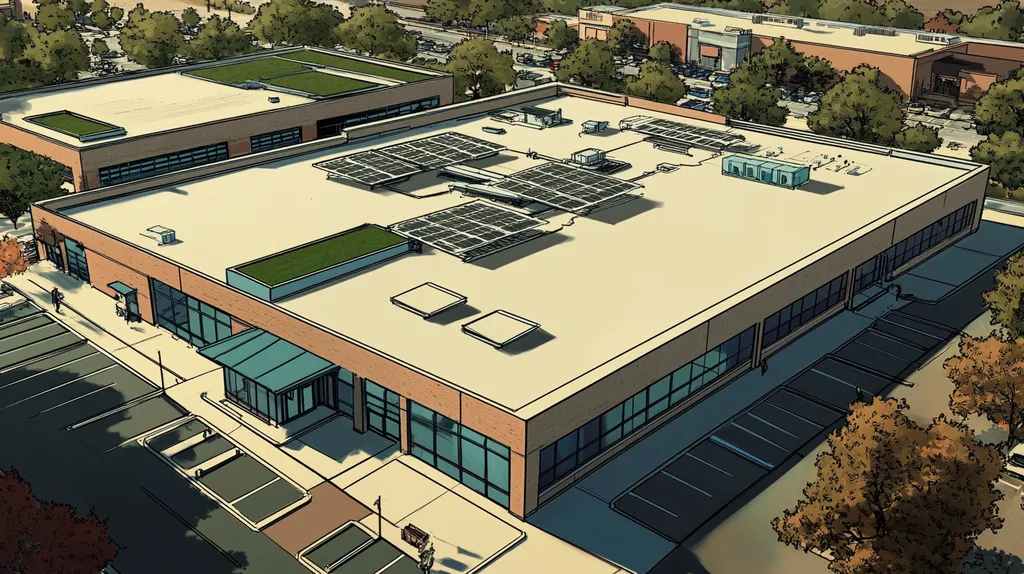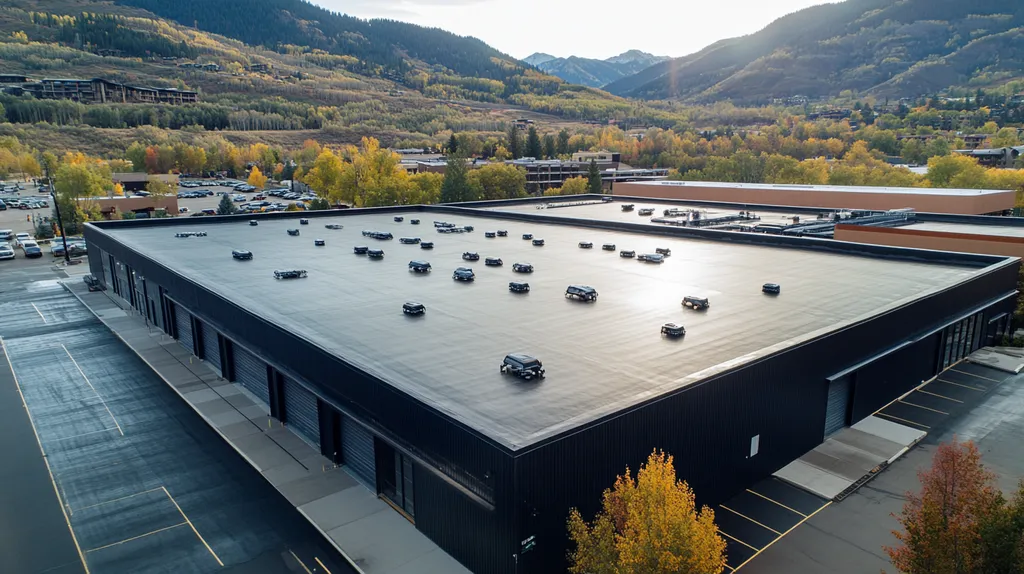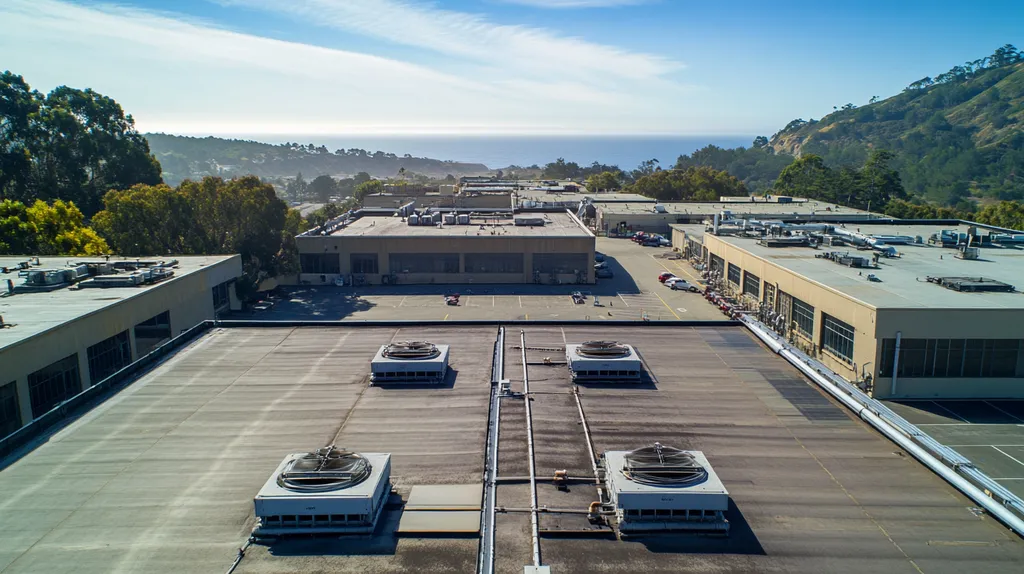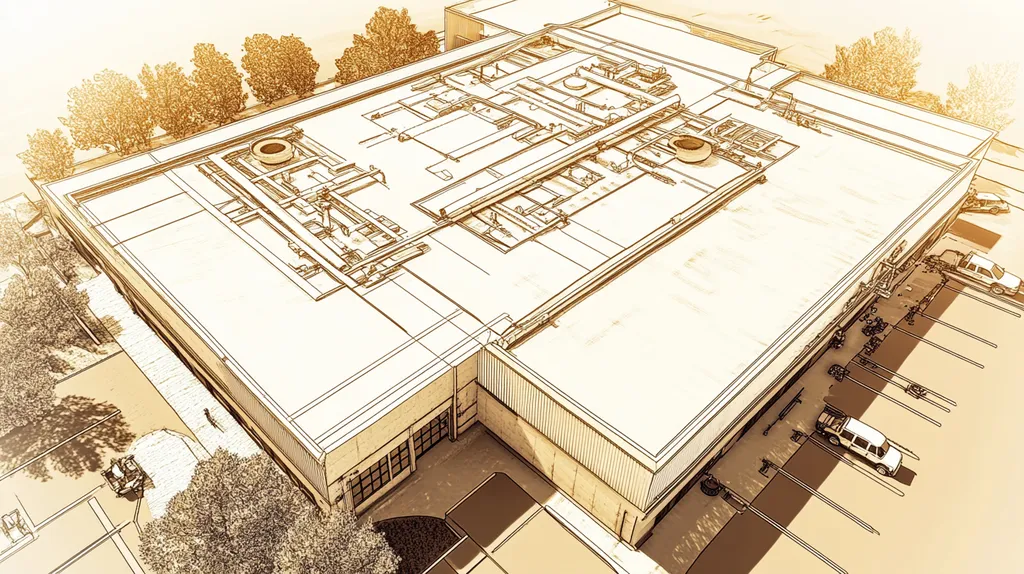Commercial roof failures cost U.S. businesses over $2.5 billion annually in emergency repairs, yet 85% of these catastrophic incidents could be prevented through proper maintenance programs.
Despite these stark statistics, dangerous misconceptions about preventive maintenance continue to put commercial properties at risk of premature roof failure and skyrocketing repair costs.
This comprehensive guide separates fact from fiction regarding commercial roof maintenance, examining the true costs of common myths while providing evidence-based solutions for protecting your roofing investment.
SECTION 1: COMMON MISCONCEPTIONS
Commercial roofing maintenance often falls victim to dangerous misconceptions that can compromise building integrity and safety. Industry data shows that neglected maintenance can slash a roof’s functional lifespan by up to 50% while multiplying repair costs. Understanding and addressing these misconceptions is crucial for protecting your roofing investment and ensuring continuous building operations.
Preventive Maintenance Is Only for Aging Roofs
The belief that new roofs are maintenance-free represents a costly misconception. Even recently installed commercial roofs require regular preventive care to perform optimally and meet warranty requirements.
Installation defects often remain hidden during the first few years, only becoming apparent when they’ve already caused significant damage. Early detection through routine maintenance can prevent these minor issues from escalating.
Environmental factors like UV exposure, temperature fluctuations, and debris accumulation affect roofs regardless of age. Regular maintenance helps identify and address these impacts before they compromise roof integrity.
Warranty compliance typically requires documented maintenance from day one. Skipping early maintenance can void manufacturer warranties and leave building owners fully exposed to repair costs.
Roof Inspections Are Unnecessary Without Visible Damage
“Regularly inspecting and maintaining roof surfaces, drains and downspouts is critical to an overall building preventive maintenance program.” (source: Travelers Insurance)
By the time damage becomes visible from ground level, the underlying problem has typically existed for months or years. Hidden issues like moisture infiltration can compromise structural integrity long before surface signs appear.
Professional inspections can detect early warning signs such as membrane deterioration, failing seams, or compromised flashings. These subtle indicators often escape untrained observation.
Regular inspections also help maintain proper drainage systems, preventing water pooling that can lead to premature roof failure. Proactive identification of potential issues prevents emergency repairs and extends roof longevity.
Minor Repairs Can Be Ignored Until Annual Checks
Delaying minor repairs creates a dangerous cascade effect where small issues evolve into major problems. What begins as a minor seam separation can quickly become a significant water infiltration point.
The cost differential between immediate minor repairs and delayed major repairs can be substantial. Small fixes often require minimal materials and labor, while waiting can necessitate extensive repairs or premature replacement.
Weather events and seasonal changes can rapidly worsen existing damage. A minor issue discovered in spring can become a major liability by winter if left unaddressed.
Prompt attention to minor repairs helps maintain the roof’s protective function and prevents collateral damage to interior systems. This approach maximizes the return on your roofing investment while minimizing business disruption.
SECTION 2: PRACTICAL IMPLICATIONS
Commercial roof failures rarely happen suddenly – they result from cascading effects of deferred maintenance that compound over time. Industry data shows that 90% of premature roof failures stem from overlooked maintenance issues that could have been prevented. Understanding these practical implications is essential for facility managers who want to protect their building assets and avoid costly emergency repairs.
Undetected Leaks Lead to Structural Compromise
Water infiltration represents the single greatest threat to commercial roof integrity. Even small leaks can saturate insulation, corrode fasteners, and compromise structural elements long before visible damage appears inside the building.
The financial impact of undetected leaks extends far beyond simple repairs. When water breaches the building envelope, it can damage inventory, disrupt operations, and create liability issues through slip hazards or mold growth.
Modern thermal imaging and moisture detection technology can identify potential leak points before water penetrates the building interior. Early detection through these methods typically reduces repair costs by 75% compared to waiting for visible damage.
Addressing leaks promptly also prevents secondary damage to adjoining building systems like HVAC equipment, electrical systems, and interior finishes. This comprehensive protection approach maintains building value while reducing total ownership costs.
Ignored Debris Accelerates Membrane Deterioration
Debris accumulation creates multiple paths for roof system failure. Organic materials trap moisture against the roof surface, accelerating chemical breakdown of roofing membranes and creating ideal conditions for vegetation growth.
Physical damage occurs when wind-blown debris scrapes and scours roof surfaces. Sharp edges can puncture membranes, while heavier items may impact with enough force to compromise underlying insulation.
Chemical deterioration results from decomposing organic matter, which creates acids that attack roofing materials. This process significantly reduces membrane life expectancy, often cutting it by 30-50%.
Regular debris removal and surface cleaning preserve membrane integrity and prevent premature aging. These simple maintenance steps help ensure roofing systems reach their full expected service life.
Poor Drainage Maintenance Causes Water Pooling Issues
Proper drainage represents a critical yet often overlooked aspect of roof performance. “Regularly inspecting and maintaining roof surfaces, drains and downspouts is critical to an overall building preventive maintenance program.” (source: Travelers Insurance)
Standing water adds significant weight stress to roof structures. Just one inch of water adds five pounds per square foot of load, potentially exceeding design limits during extended pooling.
Clogged drains and downspouts force water to find alternate paths off the roof, often through vulnerable areas like seams and penetrations. This uncontrolled water movement creates new leak pathways and accelerates existing problems.
Winter freeze-thaw cycles make drainage issues especially dangerous. Trapped water expands when frozen, forcing apart seams and creating new entry points for moisture infiltration.
Regular drainage maintenance prevents these issues by ensuring water flows properly off the roof surface. This includes cleaning drains, testing downspouts, and addressing low spots that could trap water.
SECTION 3: COST OF MISINFORMATION
Misconceptions about commercial roof maintenance create a dangerous financial ripple effect across building operations. Industry data reveals that emergency repairs stemming from maintenance neglect typically cost 300-500% more than preventive care. This stark reality affects not just immediate repair budgets, but also long-term property values, insurance costs, and overall building performance. Understanding these financial implications is crucial for making informed maintenance decisions.
Emergency Repairs Incur 3-5X Higher Costs
Emergency roof repairs represent one of the most expensive consequences of deferred maintenance. What starts as a minor issue requiring simple repair can quickly escalate into a major structural problem demanding immediate attention.
The cost differential between planned maintenance and emergency response is dramatic. While preventive repairs might cost $2-3 per square foot, emergency work often exceeds $10-15 per square foot due to overtime labor, expedited materials, and water damage remediation.
Business disruption compounds these direct costs. Emergency repairs frequently force partial or complete operational shutdowns, leading to lost productivity and revenue.
After-hours and weekend emergency response fees can triple standard labor rates. This premium pricing reflects the urgent nature of these repairs and the need for immediate mobilization.
Premature Roof Replacement Shortens Investment Lifespan
Neglected maintenance dramatically reduces roof system longevity. Commercial roofs designed to last 20-25 years often require replacement in just 7-10 years when preventive care is overlooked.
Early replacement costs extend far beyond the new roofing materials. Additional expenses include tear-off and disposal fees, potential structural repairs, and temporary protection measures during installation.
Modern commercial roofing systems represent substantial capital investments, often ranging from $10-30 per square foot. Premature replacement effectively doubles this lifetime cost while reducing return on investment.
The financial impact ripples through building valuations. Properties with documented maintenance histories and properly functioning roof systems command higher market values and better financing terms.
Insurance Premiums Rise with Neglect-Related Claims
“Regularly inspecting and maintaining roof surfaces, drains and downspouts is critical to an overall building preventive maintenance program.” (source: Travelers Insurance)
Insurance carriers carefully track maintenance-related claims patterns. Multiple claims stemming from deferred maintenance often trigger premium increases or coverage restrictions.
Water damage claims particularly impact insurance costs. These incidents typically involve multiple building systems and require extensive documentation to prove they weren’t preventable.
Some carriers now require documented maintenance programs for coverage renewal. Buildings without verifiable maintenance histories face higher premiums or possible policy non-renewal.
Risk management assessments increasingly focus on maintenance practices. Properties demonstrating proactive maintenance typically qualify for preferred pricing and coverage terms.
SECTION 4: REALITY CHECK
Commercial roofing represents a critical investment that demands careful attention to maximize returns and protect building assets. Industry data shows that proper maintenance can double a roof’s functional lifespan while reducing energy costs by up to 30%. Yet many property owners continue operating without comprehensive maintenance programs, putting their buildings at risk and missing opportunities for substantial cost savings.
Routine Maintenance Doubles Typical Roof Longevity
Statistical evidence demonstrates that maintained commercial roofs consistently achieve 20-30 year lifespans, while neglected systems often fail within 10-15 years. This dramatic difference directly impacts both operational costs and capital planning.
Regular inspections help identify and address minor issues before they evolve into major problems. A small investment in preventive care typically yields a 500-700% return through extended roof life and avoided emergency repairs.
Professional maintenance programs protect vital roof components from premature deterioration. Proper care of membranes, flashings, and drainage systems helps preserve the entire roofing assembly.
Documentation of routine maintenance also helps preserve manufacturer warranties. Most warranty claims require proof of ongoing preventive care to maintain coverage.
OSHA Compliance Requires Proactive Safety Audits
“OSHA recommends proactive safety audits as part of a comprehensive preventive maintenance program to ensure worker safety during roof inspections and repairs.” (source: Travelers Insurance)
Safety audits must evaluate both physical roof conditions and maintenance procedures. This includes checking fall protection systems, access points, and hazard communication protocols.
Regular safety reviews help identify potential risks before accidents occur. This proactive approach reduces liability exposure while protecting maintenance personnel.
Comprehensive safety programs integrate with routine maintenance schedules. This coordination ensures all roof work follows established safety protocols.
Energy Costs Directly Tied to Roofing Integrity
Roof system performance significantly impacts building energy efficiency. Deteriorating insulation and compromised membranes can increase HVAC costs by 15-25% annually.
Proper maintenance preserves the roof’s thermal resistance capabilities. Regular inspections help identify areas where insulation has become compressed or damaged.
Modern roofing materials offer enhanced energy performance when properly maintained. Reflective coatings and proper drainage help optimize thermal management.
Strategic maintenance timing can maximize energy benefits. Scheduling intensive work during moderate weather helps minimize indoor climate disruption.
SECTION 5: EVIDENCE-BASED ALTERNATIVES
Modern commercial roofing demands sophisticated maintenance approaches backed by data and technology. Industry statistics show that buildings implementing comprehensive inspection protocols and predictive systems reduce emergency repairs by 85% while extending roof life by 40%. Yet many facilities still rely on outdated maintenance methods that leave their roofing assets vulnerable to premature failure and unexpected costs.
Customized Inspection Checklists with 50+ Parameters
Comprehensive inspection protocols form the foundation of effective roof maintenance. Digital checklists incorporating over 50 critical parameters help maintenance teams systematically evaluate every aspect of roof condition, from membrane integrity to drainage performance.
These detailed assessments generate actionable data for maintenance planning. By tracking changes over time, facility managers can identify deterioration patterns and allocate resources more effectively.
Modern checklist systems integrate with building management software for real-time updates. This technology enables rapid response to emerging issues while maintaining detailed maintenance histories.
Regular evaluation of inspection results helps refine and update checklist parameters. This continuous improvement process ensures maintenance protocols evolve with changing building conditions and environmental factors.
Biannual Professional Cleaning and Gutter Servicing
“Regularly inspecting and maintaining roof surfaces, drains and downspouts is critical to an overall building preventive maintenance program.” (source: Travelers Insurance)
Professional cleaning removes damaging debris and contaminants that accelerate roof deterioration. This process includes pressure washing appropriate surfaces, clearing drainage paths, and documenting potential problem areas.
Specialized equipment and trained technicians ensure thorough cleaning without damaging roofing materials. This expertise helps preserve protective coatings and maintain warranty compliance.
Coordinated gutter maintenance prevents overflow and water intrusion issues. Regular servicing includes debris removal, downspout testing, and seam inspection to maintain proper drainage.
Predictive Leak Detection Systems for Early Intervention
Advanced moisture detection technology transforms reactive maintenance into proactive protection. These systems use sensors to monitor roof conditions 24/7, identifying potential leaks before visible damage occurs.
Real-time monitoring enables immediate response to developing issues. Alert systems notify maintenance teams when moisture levels exceed acceptable thresholds, preventing minor problems from escalating.
Integration with building automation systems enhances overall facility management. Data from leak detection equipment helps optimize maintenance scheduling and budget allocation.
Historical performance data supports long-term planning decisions. Detailed records of moisture events and system responses help justify maintenance investments while demonstrating ROI.
SECTION 6: TEST AND VERIFY
Commercial roofing systems demand rigorous testing and verification to protect substantial property investments. Industry data shows that 85% of catastrophic roof failures could have been prevented through proper testing protocols. Without systematic verification methods, hidden issues can compromise structural integrity long before visible signs appear, leading to premature failure and emergency repairs that cost 3-5 times more than preventive measures.
Third-Party Warranty Validation Through Documentation
Comprehensive documentation forms the foundation of warranty protection for commercial roofing systems. Third-party validation ensures that installation, maintenance, and repair records meet manufacturer specifications and support future claims.
Digital documentation systems help track all roof-related activities, from initial installation through ongoing maintenance. This systematic approach creates an unbroken chain of evidence that strengthens warranty coverage and simplifies claim processing.
Regular documentation reviews by qualified third parties can identify potential warranty compliance issues before they impact coverage. Early detection allows property owners to address these concerns while maintaining full warranty protection.
Professional validation services also help optimize maintenance scheduling by identifying patterns and trends in roof performance. This data-driven approach ensures resources are allocated effectively while maintaining warranty compliance.
Infrared Scans for Hidden Moisture Intrusions
Thermal imaging technology revolutionizes moisture detection in commercial roofing systems. Regular infrared scans can identify water infiltration long before visible damage appears, preventing extensive structural deterioration.
Modern infrared equipment can detect temperature variations as small as 0.2 degrees, pinpointing exact locations of moisture intrusion. This precision allows maintenance teams to target repairs effectively while minimizing disruption to building operations.
Seasonal scanning programs help track moisture patterns and evaluate drainage effectiveness. Understanding these patterns enables proactive maintenance that prevents water accumulation and extends roof longevity.
Integrating scan results with building management systems creates comprehensive performance records. This documentation supports maintenance planning while providing evidence for warranty claims and insurance purposes.
Core Sampling to Assess Subsurface Degradation
“Regularly inspecting and maintaining roof surfaces, drains and downspouts is critical to an overall building preventive maintenance program.” Core sampling provides essential data about subsurface conditions that affect drainage and structural integrity. (source: Travelers Insurance)
Strategic sampling locations help evaluate insulation compression, membrane adhesion, and deck condition. This information guides repair decisions and helps predict potential failure points before they compromise roof performance.
Laboratory analysis of core samples can identify chemical degradation and material fatigue. Understanding these factors helps maintenance teams select appropriate repair materials and methods.
Documented core sampling results provide valuable baseline data for long-term performance monitoring. Regular comparisons help track degradation rates and optimize maintenance intervals.
The Bottom Line
With commercial roof failures costing U.S. businesses over $2.5 billion annually in emergency repairs, the stakes for proper maintenance couldn’t be higher.
The evidence is clear: preventive maintenance programs extend roof life by 100%, reduce emergency repair costs by 75%, and lower energy expenses by up to 30%.
Modern testing protocols, from infrared scanning to core sampling, now provide unprecedented ability to detect and prevent failures before they occur.
The choice facing commercial property owners is stark: invest in systematic maintenance programs or risk catastrophic failures that cost 3-5 times more to repair.
The time for relying on outdated maintenance myths has passed – today’s commercial roofing demands data-driven, proactive protection to safeguard these critical building assets.
FREQUENTLY ASKED QUESTIONS
Q. Is preventive maintenance only necessary for aging commercial roofs?
A. This is a common misconception. Even new roofs require regular preventive care to ensure optimal performance and comply with warranty requirements. Hidden installation defects may surface over time, and regular maintenance can help identify these issues early, preventing greater damage.
Q. How do undetected leaks affect commercial roofs?
A. Undetected leaks can lead to significant structural damage as they compromise insulation and fasteners. Furthermore, they may cause damage to inventory and create hazardous conditions within buildings, ultimately leading to costly repairs and complications.
Q. What are the costs associated with emergency repairs for commercial roofs?
A. Emergency repairs are significantly more expensive than preventive maintenance, often costing three to five times more. This includes emergency labor, expedited materials, and potential operational disruptions that can lead to lost revenue.
Q. How can routine maintenance extend a commercial roof’s lifespan?
A. Regular inspections and maintenance can double a roof’s typical lifespan by addressing minor issues before they become serious problems. This proactive approach reduces repair costs and preserves the roof’s performance, maximizing the return on your investment.
Q. What are the benefits of modern inspection technologies for commercial roofs?
A. Modern technologies, like thermal imaging and predictive leak detection, can identify issues before they become visible. These tools enhance the effectiveness of maintenance efforts, allowing for timely interventions that save money and extend roof life.
Q. How does debris affect the integrity of a commercial roof?
A. Accumulated debris creates conditions that accelerate membrane deterioration and can lead to physical damage. Organic matter holds moisture against the roof, resulting in chemical breakdown and vegetation growth, drastically reducing the roof’s life expectancy.
Q. What steps can be taken to ensure proper drainage on a commercial roof?
A. Regular maintenance, such as cleaning drains and gutters, ensures proper water flow off the roof. Inspecting for low spots and addressing potential blockages helps prevent pooling, which can lead to significant damage and structural issues.











